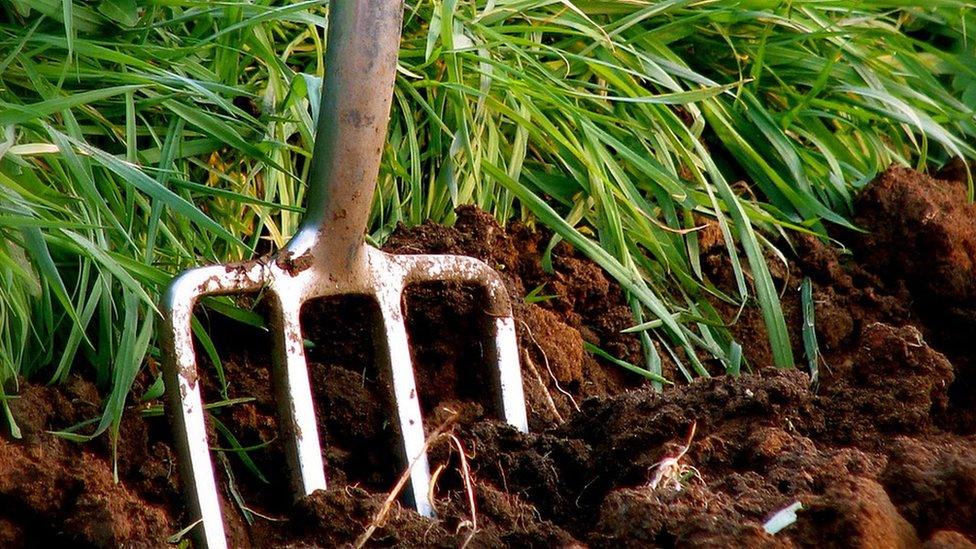Urban dwellers yearn for 'Good Life' allotments
- Published
- comments

It is estimated that about 100,000 people in the UK are waiting for allotment plots
Land set aside for allotments in the UK has declined by 65% from a peak in the "dig for victory" and post-war era.
Scientists estimated that the lost allotments could have provided 6% of the population with their "five-a-day" fruit and veg diet.
The most deprived areas suffered the worst decline, experiencing eight times the level of allotment closures compared with the most affluent areas.
The study's findings appear in the Landscape and Urban Planning journal.
"We found that, overall, there had been a 65% decline in the total area of allotment land from its peak (1950s) to 2016," explained co-author Miriam Dobson from the University of Sheffield.
"In terms of the amount of the amount of food production capacity lost, the closed allotment land could have fed 6% of the population on their 'five-a-day' diet."

"Lost allotments" could provide 6% of the UK population with their five-a-day fruit and veg
The researchers decided to assess the volume of land set aside for allotments because although it was widely assumed that there had been a decline since the peak during the "dig for victory" and post-war years, there was no data available.
The team also wanted to understand if any of the former allotments could be reinstated as allotments to meet the renewed demand for allotments.
They said that the waiting list for an allotment plot was an estimated 100,000 people in 2013.
To gather the data it needed, the study looked at 10 geographically distributed cities across the UK, using historical Ordnance Survey maps of the 20th Century. It was then possible to plot the land used as allotments and monitor land-use change over the decades.
Ms Dobson, a PhD student at the university's Department of Animal and Plant Sciences, said there were a number of factors behind the reduction of allotment plots.
"There was reduced demand after the 1950s as people relied more on supermarkets and convenience stores," she told BBC News.
"There was also a loss in leisure time, which meant people did not have the time to attend to their allotment plots, and a loss of food growing knowledge created barriers to entry.
"As well as this, as the urban population was growing, urban land became increasingly valuable to developers."

The researchers estimated that about a quarter of the "lost allotments" could be used once again to grow fruit and veg
Yet regarding the allotment sites that had been closed, the team found that about a quarter of the land had not been developed for buildings but had been used as another form of green space.
"If the land within this was potentially suitable for reconversion to allotments was changed back to food production, the space available could meet up to 100% of the waiting list demand in the cities," observed Ms Dobson.
In recent years, the demand for allotment plots has seen a renaissance, which many younger people wanted to grow their own fruit and veg, rather than it being seen as the preserve of pensioners.
During the Covid-19 lockdown, people with allotments have been spending a lot of their time on their plots, growing plenty of fresh fruit and veg - which, at times, have been challenging to source in supermarkets.
Ms Dobson observed: "We have already seen a huge increase in the number of people interested in growing their own food as a result of coronavirus, with garden centres and online shops selling out of seeds in the first weeks of lockdown.
"Coronavirus has… highlighted to people the fragility inherent within our globalised food system. In a time of crisis, interest in self-sufficiency rises.
She added that she felt there would likely be a surge in demand for allotment following this pandemic.
The team felt their study showed the importance of making sure that urban food production, such as allotments, were protected from being shut down, as well as highlighting the potential to expand such sites in towns and cities to meet demand.